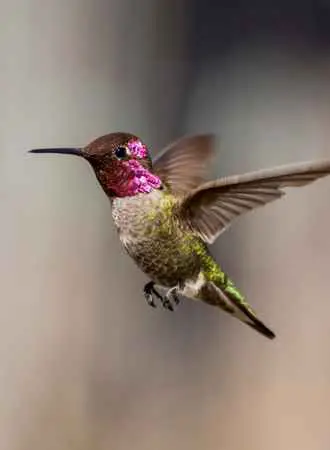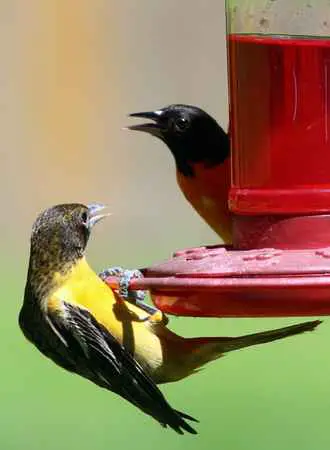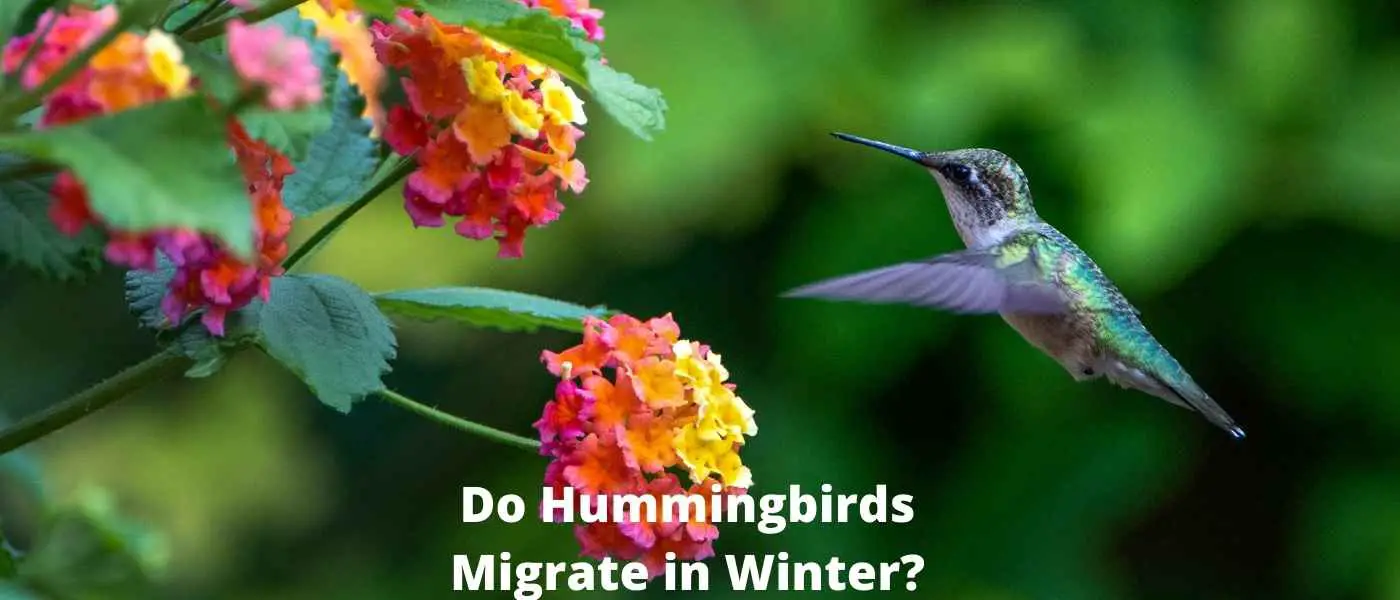Although there are more than 300 hummingbird species, only a few migrate on a regular basis. Most North American hummingbirds migrate seasonally between northern breeding grounds and southern wintering sites.
Migration typically occurs in the fall, as migrating hummingbirds head south to escape the cold weather.
However, some hummingbirds do remain in their northern homes throughout the winter months. These hardy birds are able to survive the cold temperatures by seeking shelter in dense foliage or entering a state of torpor, a type of hibernation.
Why Do Hummingbirds Migrate?
Hummingbirds have predictable migration patterns. Every year, these birds travel hundreds or even thousands of miles to reach their winter destinations. But why do they migrate?
Like many other birds, breeding hummingbirds travel south for the winter, traveling to warmer climates in search of food sources. They are not driven by hunger or falling temperatures but by decreasing daylight hours.
In the months leading up to winter, days become shorter and nights become longer. This change in light patterns cues the hummingbirds to start migrating. As they travel south, they take advantage of the plentiful food sources that are available in warmer climates.
Once spring arrives and days begin to lengthen again, the hummingbirds head back north to their breeding area. For these migratory birds, migration is a necessary adaptation that helps them survive the changing seasons.

How Do Ruby-Throated Hummingbirds Migrate?
Ruby-throated Hummingbirds are among the many bird species that regularly migrate south annually. These birds claim a breeding range from the Gulf Coast north well into Canada.
Migrating birds typically travel to warmer climates in the winter and cooler climates in the summer. For ruby-throats, this means traveling non-stop to cross the Gulf of Mexico and spending the winter in Central America, and flying back to North America in the spring.
The journey is a long one, and most ruby-throats make the trip by flying across the Gulf of Mexico. This non-stop flight can be up to 500 miles long. And hummingbirds spend several days completing the migration.
Once they arrive at their destination, they will spend the next several months feeding, resting, and preparing for their return journey north.
Do Hummingbirds Travel to Southern Mexico?
Yes, most of the hummingbirds of Eastern North America travel to the Gulf Coast, usually to Southern Mexico and Central America. The ruby-throated hummingbird is one of the most common species of hummingbird found in North America, and every year, thousands of these little birds fly south for the winter.
Other hummingbird species that travel south include Allen’s hummingbird and Buff-bellied Hummingbird and the black-chinned hummingbirds of southern British Columbia. The black-chinned hummingbird population occupies a large portion of the western United States as well. They travel south as far as Central Mexico.
The journey from their summer homes in Canada and the northeastern United States to their wintering grounds in Mexico can be as long as 2,000 miles. Along the way, they must stop frequently to rest and refuel on nectar from flowers.
There have been hummingbird sightings in South Carolina, Tennessee, Southern California, and Southern Texas as well.
However, some hummingbirds don’t complete their journey further south and instead spend their winter months in the milder climates of the West Coast, Central Texas, and South Texas where they can find locations with abundant food supplies because most hummingbirds consume up to 50 percent of their body weight in nectar each day.

Do Rufous Hummingbirds Migrate?
Rufous Hummingbirds are among the most dedicated of all migrating birds. Every year during hummingbird migration, the rufous hummingbird species travel nearly 4,000 miles from their breeding areas in Alaska and northwest Canada to their wintering grounds in Mexico.
Their journey takes them along the Pacific Coast, and they often use the Rocky Mountains as a navigation aid on their way back north in late summer and fall. Because of the great distances involved, rufous hummingbirds must make several stops along the way to refuel.
A rufous hummingbird typically eats small insects and nectar from flowering plants, and they visit a variety of flowers to get the nutrients they need. With such a long journey ahead of them, it’s no wonder that these birds are among the most impressive migrators in the world.
Do Anna’s Hummingbirds Migrate?
Anna’s Hummingbirds are a species of hummingbird that occupy an area from northern Mexico to Southern Canada. And of the four Pacific Northwest Hummingbirds, Anna’s Hummingbird species typically either do not migrate at all or only migrate a short distance. This is likely because the food sources they rely on – such as nectar from flowers – are readily available year-round in their natural habitat, especially during the breeding season.
As a result, you can often see Anna’s hummingbird flitting about in your garden or at parks throughout the Pacific Northwest, even in the middle of winter.

How Long Does It Take Hummingbirds to Fly South for the Winter?
Hummingbird migration happens annually. Most people are familiar with the sight of a hummingbird darting back and forth among the flowers in their garden. What many people don’t know is that these birds undertake an epic journey every year, flying south for the winter.
A hummingbird can typically travel up to 23 miles in one day, and it takes several weeks for the birds to reach their wintering grounds from their summer breeding grounds in the northern U.S. or southern Canada.
Along the way, they must contend with obstacles such as bad weather and predators. But despite the challenges, millions of hummingbirds make the journey safely every year, returning to your gardens in the spring migration.
Do Hummingbirds Migrate in Flocks?
While many birds migrate in flocks, spending the journey in close formation, hummingbirds take a different approach. Rather than migrating together, these tiny birds fly solo, striking out on their own to reach their destinations. After all, they are solitary birds. However, on some occasions, you can see these large numbers of these birds near feeders during the fall migration.

Conclusion on Hummingbird Migration
Almost all North American hummingbirds travel south to warmer climates for the winter. While there are a few species of hummingbirds that stay in the northern parts of the United States and Canada during the winter, most make their way down to Mexico or Central America.
FAQs on Do Hummingbirds Migrate
What Are the Dietary Needs of Migrating Ruby-Throated Hummingbirds?
The Ruby-throated Hummingbird is a fascinating bird species that is known for its long-distance migration. They are the only species regularly spotted in the eastern United States.
Every year, these tiny birds travel south to Central and South America from their breeding grounds. Along the way, individual hummingbirds stop to feed on nectar from a variety of flowers. And most of them increase their nectar intake considerably.
While the Ruby-throated Hummingbird will feed on nectar from over 30 plant species, they have a few preferences. For example, they prefer flowers that are red, have long tubes, and the nectar is diluted.

Should You Leave Hummingbird Feeders Out in Winter?
Hummingbird feeders are a great way to attract these fascinating little birds to your yard, and many people enjoy watching them throughout the summer months. However, you may be wondering if you should leave your feeders out in winter.
The answer is that you can keep hummingbird feeders out until the last hummingbirds fly away. Even if your local species have migrated, late migrants or out-of-range birds may still show up. like owls migrating. If you do see a hummingbird at your feeder in winter, it’s important to keep the nectar fresh and free from ice.
In addition, it’s a good idea to have a well-maintained hummingbird feeder by regularly cleaning it to prevent the build-up of mold or bacteria.
When Should You Take In Hummingbird Feeders?
Hummingbird feeders are a great way to attract these fascinating creatures to your yard or garden, but it’s important for backyard birders to know when to take them down.
In most cases, you can take the hummingbird feeder down two to three weeks after you’ve seen the last hummingbird species visit your feeder during fall migration.
This is because hummingbirds are territorial and will chase other hummingbirds away from the feeder site. If you want to put out more than one feeder, that can reduce fighting for dominant feeder rights.
However, if you live in an area where hummingbirds are present year-round, you can leave your feeders up all year. Keep an eye on the hummingbird migration routes and check a migration map to see when hummingbirds are in your area and when they might be moving on.



